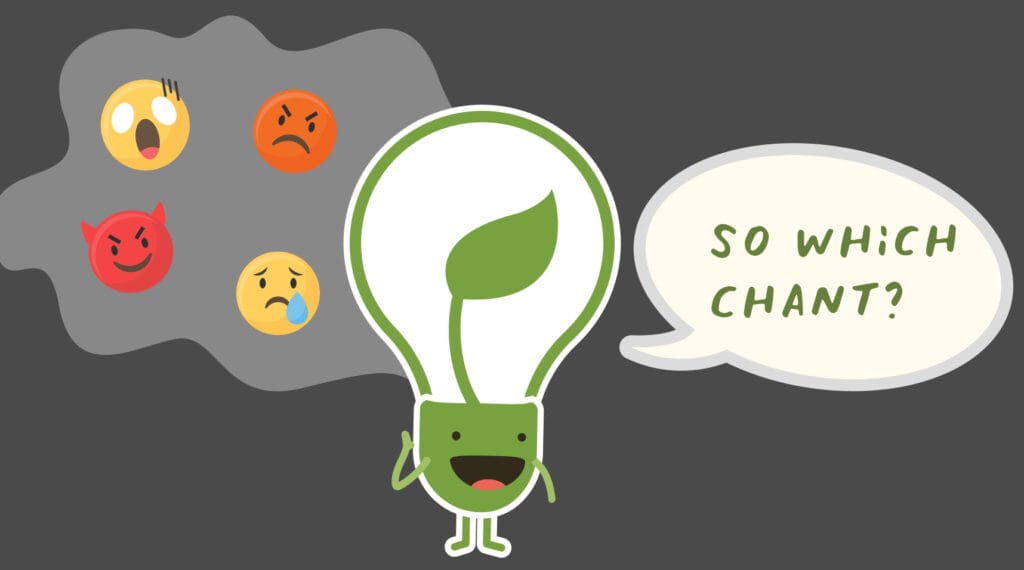TLDR: Chanting keeps the mind afloat on the choppy waves of suffering. Connecting you to others across time and space, the ritual of chanting creates a refuge from pain. The healing device of chanting is anything but boring!
Yeap, you read it right. Chanting is crazy helpful. Especially when the mind goes crazy. To a non-believer, chanting can be an unfathomable activity – boring, even superstitious. To a practitioner, chanting cleanses the mind.
Let us understand what chanting is and how it heals.
Chanting Tickles Your Right-Brain

Relying on synchronised tunes and steady rhythms, chanting vocalises the Buddha’s teachings, recollections and praises for the Triple Gem.
Chanting is the ‘feeling’ and ‘healing’ part of a logical and pragmatic religion-philosophy. Done with full intent and focus, chanting soothes the heart like a balm. Cooling and stilling afflictions. Warming and uplifting the mind.
Short of comparing chanting to singing your favourite soundtrack mindfully in full earnest, the voicing of “lyrics” falls within a short range of inflecting tones without musical accompaniment. Chanting with the right understanding of familiar verses leads to joy and peace. Sometimes, tears. On auspicious occasions, goosebumps.
The volitional act of voicing out the Buddha’s teachings, never mind the tune, pledges one’s faith that the Dhamma leads beings out of suffering. This verbal allegiance is not for show but to remind ourselves of the Truth time and again.
Because we forget. In this way, chanting instils a sense of belonging – to the Triple Gem, to a wholesome way of life, to a practice of training towards the human fullest potential, to kindness. To hope.
Knowing how to chant, one plugs into a common Buddhist ritual that binds all differences – nationality, language, race, class, culture, those suffering and those enlightened. Cutting across space and time, in your home, at any temple, in a forest, on mountain tops or at the Buddist holy sites in India — wherever, whenever, chanting connects you to a community of practitioners since Lord Gotama Buddha’s time.
The key to a spiritually satisfying chanting session is then learning how to chant and what to chant, in which language.
The Ritual of Chanting
Typically, chanting is part of a practitioner’s morning and evening routines. Depending on the Buddhist tradition, chanting involves varying extents of ritual, usually set in front of an altar, where possible. Due to my upbringing, I have the fortune of learning how to chant in both the Mahayana (Chinese) and Theravadin (Thai Forest) traditions. Having experienced both, I feel more connected to the latter, which I will give a little exposé below.
Simple in tones and expressions, without instrumental accompaniment, Theravadin chanting is mainly in the Pāli language, an ancient vernacular during Lord Buddha’s time. Disciples of the Thai Forest Tradition alternate between Pāli and translations in their first languages, such as Thai, English, German, and Chinese etc.
From experience, searching up the translated meaning of Pāli verses before chanting helps to quell the critical mind.
After offering incense or candlelight or flowers and paying respects to the Triple Gem by bowing, you put your palms together in añjali, kneeling or sitting with your knees folded away from the altar. If you have learnt the words by heart, close your eyes. If not, set out a chanting book with translation nearby. Gather awareness on your breathing. Ready the mind for spiritual connection.
Then, the chanting begins.
Regardless of chanting in private or in public, alone or in a group, a keen sense of ego arouses when projecting the voice initially.
To avoid suffering, you can set aside that notion of “me/mine/myself” for clear awareness to arise. As the Dhamma rings in your ears and through your body, the vocal cords sync with a sincere heart.
The mind arrives at each articulated word to soak in its meaning.
Peace ensues. Chanting creates a refuge for the moment amidst chaos.
What chants can I turn to?

There is a chant for any time and occasion to counter greed, hatred and delusion, which reside in our hearts since the beginning of time.
Some recollections are snippets of the Buddha’s exhortations; others are full discourses considered as protective chants. Some typical chants a lay practitioner has in his/her spiritual toolkit help uplift the mind into wholesome vibes.
For monastics, cardinal sermons are chanted to maintain the oral tradition of preserving the Buddha’s discourses. Particular recollections pertain to arousing dispassion towards worldly attachments and urgency for practising the Holy life. A set of chants reserved for funerals; another set for blessings.
On every Full Moon and New Moon of the lunar calendar (Uposatha Lunar Observance Days), monks gather together to chant the Vinaya Patimokkha, which is the Code of Discipline Lord Gotama Buddha set down for monastics to uphold and honour. Similarly, to upkeep their virtues, the laity would undertake the Five Precepts or Eight Precepts by chanting them on Lunar Observance Days.
Chanting plays important roles in our practice: it teaches us what is skillful and remind us to counter the stubborn poisons within our hearts.
Dr. Buddha, can you prescribe some chanting for my troubled heart?
For practitioners encountering intense emotions such as anger, sorrow, fear, anxiety or grief, listening to chanting is a helpful relief from recurring and distressing thoughts. The act of chanting brings an even greater autonomy over processing negative feelings. An effective spiritual ParacetamolTM that soothes sharp, crippling pains from my personal experience. You will always find an emergency playlist of my favourite chants in my phone on standby for breakdowns.
If you wake up grumpy, listless or sian, what better way to pick yourself up than a cup of warm water and a morning chanting?
For the past year, I made it a point to begin my day with morning chanting, regardless of how much time I have or how long the chanting is. On good days, morning chanting uplifts my mind for a quiet sit. On bad days, chanting seems to be the only wholesome thing I can cling on to for my life. Chanting has since become my anchor in the tumultuous waves of negative emotions.
Without chanting, I am pretty sure I would not have made it through difficult times to be here and write. Crazy helpful, I’d say.
I have listed a couple of resources to support your journey with chanting in the Theravadin Thai Forest Tradition below. Hope you will find a chant that resonates.
Chanting Books with translation:
Amaravati Monastery: Chanting Vol 1; Chanting Vol 2 – Parittas and Suttas
Chanting Audio Recordings:
Spiritual Toolkit:
| Chant | Function |
|---|---|
Supreme Qualities of the Triple Gems Refuge in Triple Gem | Arouses faith in the Buddha’s Dispensation |
| Buddha’s Words On Loving-kindness | Counters anger and ill-will |
Reflection on Universal Well-Being | Generates goodwill, compassion, sympathetic joy and equanimity |
Five Subjects For Frequent Recollection | Provokes reflection on impermanence of life and the law of kamma (causation and effect) |
Reflection on Thirty-two Parts | Arouses dispassion toward sensuality and the body. Curbs greed and corrects distorted perception of the body’s reality |
Verses of Sharing and Aspiration | Cultivates gratitude and stirs resolution to practice. Shares merits with all beings |
The Highest Blessings | Cultivates gratitude. Acts as protective chant |
The Turning of Dhamma-Wheel Discourse Dhammacakkapavathana Sutta | One of the cardinal discourses. Instils understanding of core teachings. Corrects delusion |
Wise Steps:
- Pick up a chanting book and learn a few chants in Pāli and English, although no one is stopping you from learning Thai.
- Listen to some of the chants to learn the tunes and intonation.
- Commit to a short session of morning or evening chanting. No need to paiseh. An altar is good to have but not necessary.
- Save a list of your favourite crazy helpful chants for emergencies.


